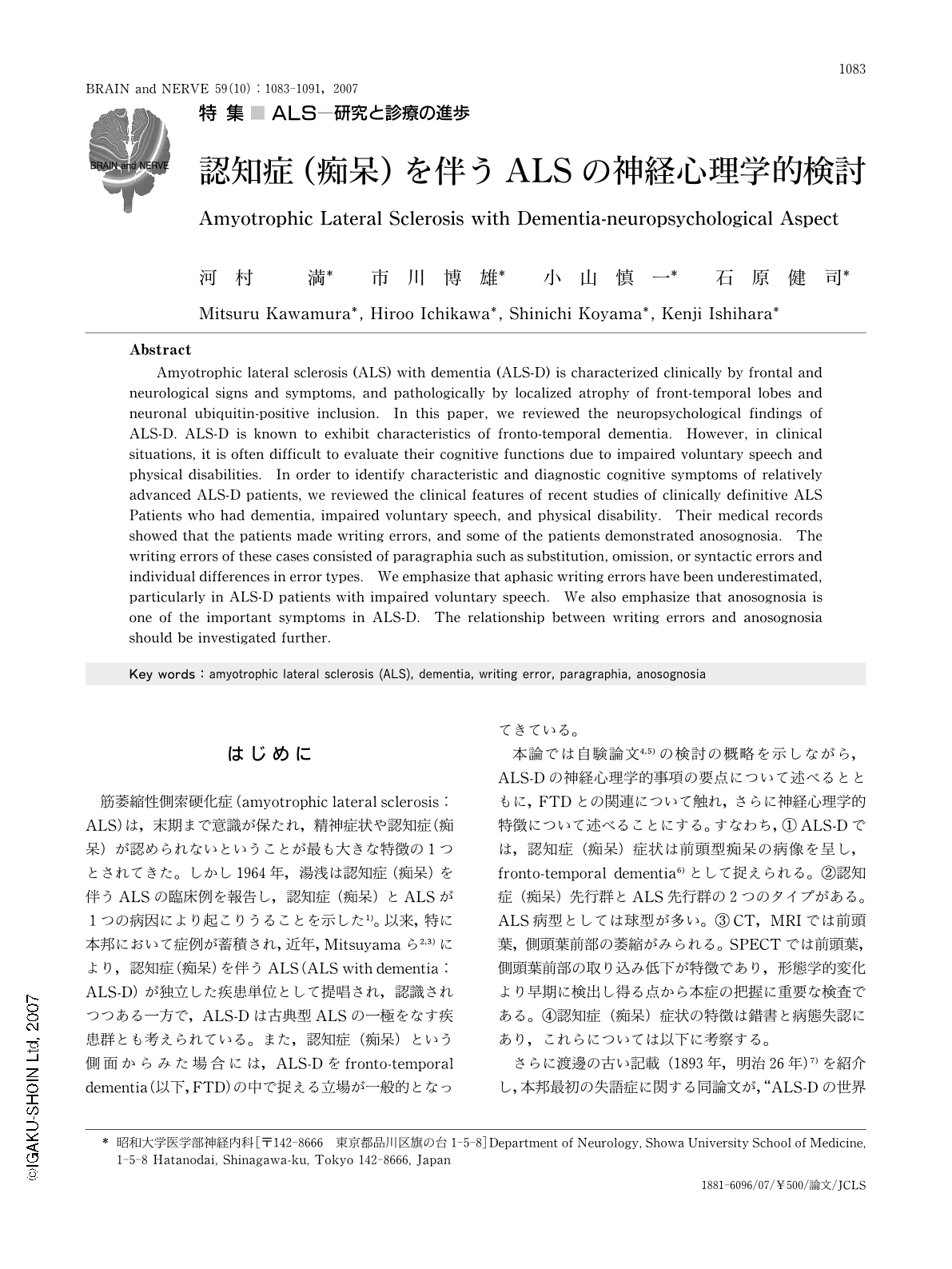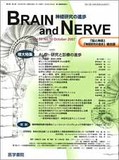Japanese
English
- 有料閲覧
- Abstract 文献概要
- 1ページ目 Look Inside
- 参考文献 Reference
はじめに
筋萎縮性側索硬化症(amyotrophic lateral sclerosis:ALS)は,末期まで意識が保たれ,精神症状や認知症(痴呆)が認められないということが最も大きな特徴の1つとされてきた。しかし1964年,湯浅は認知症(痴呆)を伴うALSの臨床例を報告し,認知症(痴呆)とALSが1つの病因により起こりうることを示した1)。以来,特に本邦において症例が蓄積され,近年,Mitsuyamaら2,3)により,認知症(痴呆)を伴うALS(ALS with dementia:ALS-D)が独立した疾患単位として提唱され,認識されつつある一方で,ALS-Dは古典型ALSの一極をなす疾患群とも考えられている。また,認知症(痴呆)という側面からみた場合には,ALS-Dをfronto-temporal dementia(以下,FTD)の中で捉える立場が一般的となってきている。
本論では自験論文4,5)の検討の概略を示しながら,ALS-Dの神経心理学的事項の要点について述べるとともに,FTDとの関連について触れ,さらに神経心理学的特徴について述べることにする。すなわち,①ALS-Dでは,認知症(痴呆)症状は前頭型痴呆の病像を呈し,fronto-temporal dementia6)として捉えられる。②認知症(痴呆)先行群とALS先行群の2つのタイプがある。ALS病型としては球型が多い。③CT,MRIでは前頭葉,側頭葉前部の萎縮がみられる。SPECTでは前頭葉,側頭葉前部の取り込み低下が特徴であり,形態学的変化より早期に検出し得る点から本症の把握に重要な検査である。④認知症(痴呆)症状の特徴は錯書と病態失認にあり,これらについては以下に考察する。
さらに渡邊の古い記載(1893年,明治26年)7)を紹介し,本邦最初の失語症に関する同論文が,“ALS-Dの世界で最初の記載であるかもしれない”ということについても触れたいと思う。
Abstract
Amyotrophic lateral sclerosis (ALS) with dementia (ALS-D) is characterized clinically by frontal and neurological signs and symptoms, and pathologically by localized atrophy of front-temporal lobes and neuronal ubiquitin-positive inclusion. In this paper, we reviewed the neuropsychological findings of ALS-D. ALS-D is known to exhibit characteristics of fronto-temporal dementia. However, in clinical situations, it is often difficult to evaluate their cognitive functions due to impaired voluntary speech and physical disabilities. In order to identify characteristic and diagnostic cognitive symptoms of relatively advanced ALS-D patients, we reviewed the clinical features of recent studies of clinically definitive ALS Patients who had dementia, impaired voluntary speech, and physical disability. Their medical records showed that the patients made writing errors, and some of the patients demonstrated anosognosia. The writing errors of these cases consisted of paragraphia such as substitution, omission, or syntactic errors and individual differences in error types. We emphasize that aphasic writing errors have been underestimated, particularly in ALS-D patients with impaired voluntary speech. We also emphasize that anosognosia is one of the important symptoms in ALS-D. The relationship between writing errors and anosognosia should be investigated further.

Copyright © 2007, Igaku-Shoin Ltd. All rights reserved.


